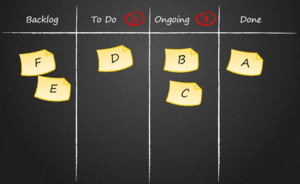Kanban framework
From apppm
(Difference between revisions)
| Line 20: | Line 20: | ||
== '''Features of the Kanban framework''' == | == '''Features of the Kanban framework''' == | ||
=== '''Visualize''' === | === '''Visualize''' === | ||
| − | Describe kanban cards and boards | + | *Describe kanban cards and boards |
=== '''Limit work in progress''' === | === '''Limit work in progress''' === | ||
| − | Stay to the script | + | *Stay to the script |
=== '''Manage flow''' === | === '''Manage flow''' === | ||
| − | Use of CDFs and WIP area charts | + | *Use of CDFs and WIP area charts |
=== '''Make process policies explicit''' === | === '''Make process policies explicit''' === | ||
| − | Securing a common understanding | + | *Securing a common understanding |
=== '''Implement feedback loops''' === | === '''Implement feedback loops''' === | ||
=== '''Improve collaboratively, evovle experimentally''' === | === '''Improve collaboratively, evovle experimentally''' === | ||
== '''Limitations of the Kanban framework''' == | == '''Limitations of the Kanban framework''' == | ||
| − | Describe what limitations there has been found when working with the Kanban framework | + | *Describe what limitations there has been found when working with the Kanban framework |
| + | *Use of Scrumban can cover some of the limitations | ||
== '''Annotated Biography''' == | == '''Annotated Biography''' == | ||
Revision as of 11:06, 11 February 2022

Figure 1: Example of a simple Kanban board [1]
Kanban can be referred to as either a method within process improvement and management or in Lean manufacturing, following article will be focusing on its uses in process improvement and management.
Kanban is a japanese word meaning signboard, and is used as a methodology to improve processes.
Contents |
Historical State of the Art
Description of how Kanban first originated and in which context is was developed. Furthermore how the Kanban method has been adopted into system development.
Kanban in Project Management
Not a methodology for project management, but has an important relationship to it.
- Start with what you do know
- Agree to pursue incremental, evolutionary change
- Initially, respect current roles, responsibilities and job titles
Use ref: Managing Successful Projects with PRINCE2 2017 Edition
Features of the Kanban framework
Visualize
- Describe kanban cards and boards
Limit work in progress
- Stay to the script
Manage flow
- Use of CDFs and WIP area charts
Make process policies explicit
- Securing a common understanding
Implement feedback loops
Improve collaboratively, evovle experimentally
Limitations of the Kanban framework
- Describe what limitations there has been found when working with the Kanban framework
- Use of Scrumban can cover some of the limitations
Annotated Biography
References
Other notable references not yet used: Books:
- Learning Agile: Understanding Scrum, XP, Lean and Kanban. By Andrew Stellman & Jennifer Greene
- Kanban: Successful evolutionary change for your technology business. By David J. Anderson
- The Lean Toolbox: A handbook for lean transformation. By John Bicheno & Matthias Holweg
Websites:
Articles:
- Identification of criteria affecting software project monitoring task of Agile Kanban method. By Hamzah Alaidaros, Mazni Omar and Rohaida Romli
- https://aip-scitation-org.proxy.findit.cvt.dk/doi/pdf/10.1063/1.5055423
- Collaborative Work Management with a Highly-Available Kanban Board. By Annette Bieniusa, Peter Zeller, and Shraddha Barke
- file:///Users/JakobWeber/Downloads/5bd0583fd9001d01d4104a4f.pdf